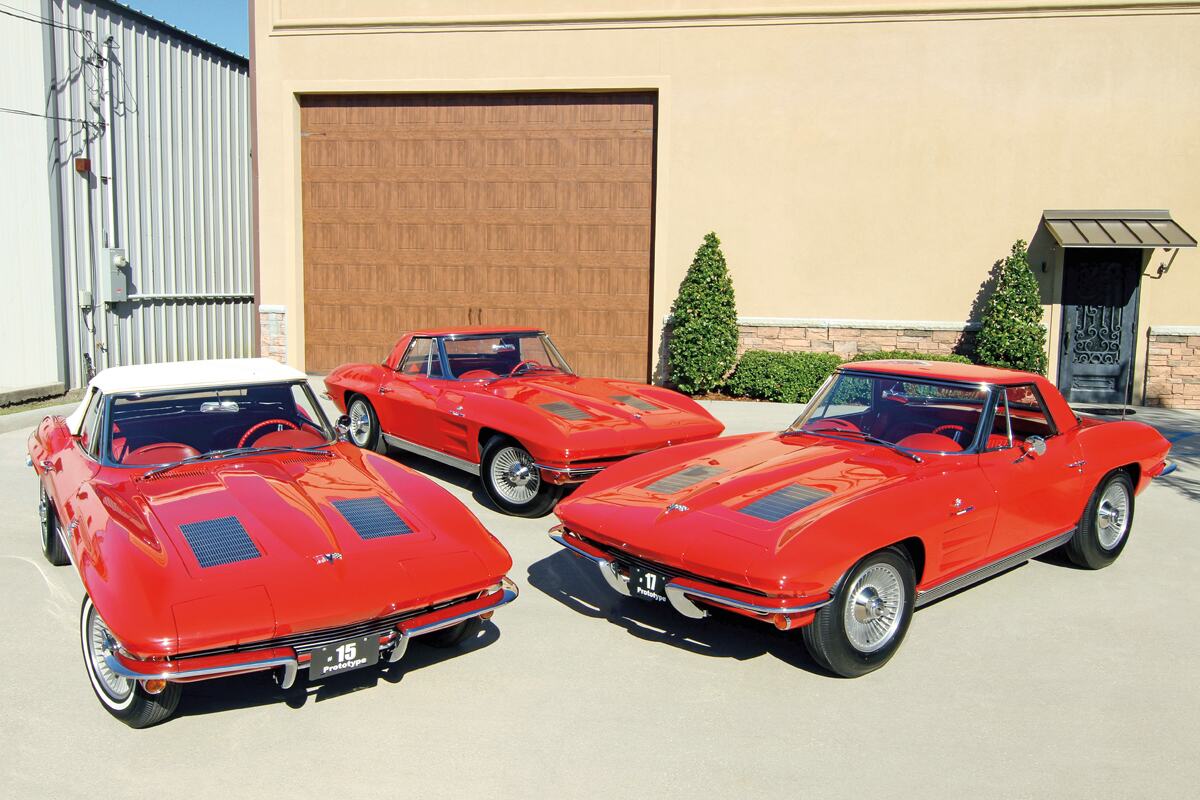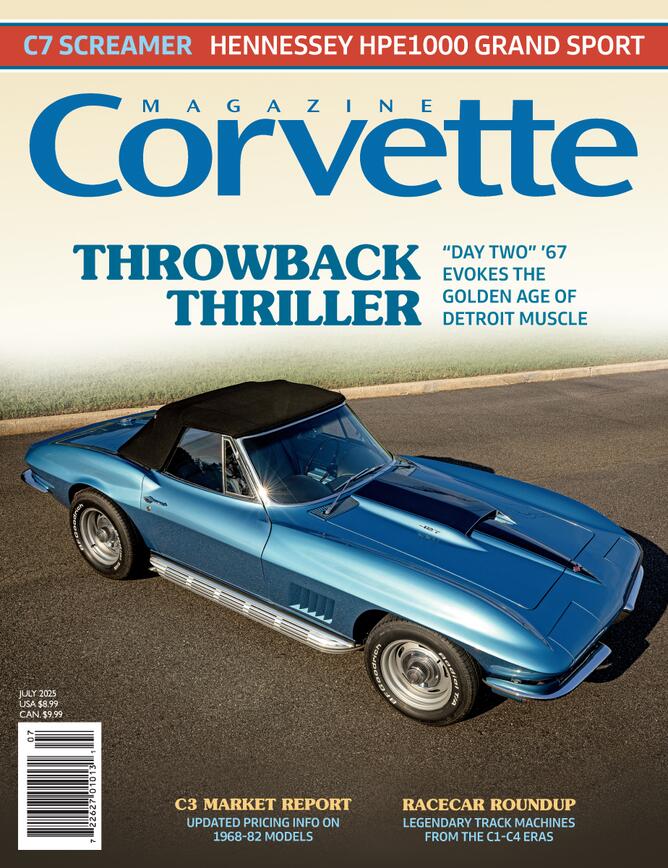Rare options. Low production numbers. Early VINs. The Corvette world brims with “one of one” cars, and honestly, the endless onslaught of rarest-of-the-rare claims can get a bit tedious.
In fact, it’s easy to tune them out, but then there is the trio of 1963 Fuelie roadsters in the collection of classic-car auctioneer Pete Vicari. Each is a hand-built prototype constructed to develop and validate the design features for the eventual production parts and their tooling. They’re also fascinating examples of living history, offering detailed glimpses at the early processes that helped move the ’63 Corvette from the drafting table to the production line.
According to Larry Galloway’s book Corvette C2 1963: The Model Year that Launched the Corvette into History, the first 23 ’63 Corvettes were prototypes, as there were no assembly-line pilot builds scheduled. That was partly due to an accelerated validation schedule ahead of the car’s official launch, which forced the team to bake many of the normal pilot-build processes into pre-production.

“They look like ’63 Corvettes, but almost everything on them is unique,” says Vicari, who’s owned the cars for about 15 years. “And even between them, there are minor differences that suggest the development teams were evaluating different design details for things such as water drainage and other little things. In that regard, each car is its own ‘unicorn,’ with unique features.”
Vicari’s cars were built in August 1962 and are sequentially numbered, including VINs 30867S00015, 00016, and 00017. And while each shows the “S” in the VIN that denotes the St. Louis assembly plant, photographic evidence of the prototypes suggests some were at least partially built in Flint, Michigan, with final assembly and tweaking taking place in St. Louis.
That’s especially true for car #16, according to Galloway’s book, which notes a number of build discrepancies even among the prototypes, along with a reported parts-shortage list, shown in photos, that suggested a diversion from the assembly line. The car may have also been used to verify and validate production tooling.

“It makes sense that at least some of the cars were built separately and not on the regular production line, especially when you see the distinctive differences in their construction,” says Vicari. “The body panels, for example, were hand-laid on mahogany bucks and don’t have the texture underneath of a production part.”
Indeed, the roster of unique elements contained in these cars is almost endless. In addition to the hand-laid fiberglass, which Vicari says resulted in much-heavier parts, most of the trim, including the badging, was poured into prototype sand molds and is comparatively brittle compared with production items.
“It’s pretty easy to lift a regular-production door, but it’s very difficult with one of these, because of their weight,” he says. “And if you look at the inner fender panels, you see how different pieces of fiberglass were patched together to make the whole part.”

The treatment is undeniably crude-looking in areas, but the construction of these prototype cars was much more about function than showroom-quality form. Additionally, the exterior color of each isn’t the 1963 Riverside Red, but the 1962 Roman Red hue, although the trim tags show the code for the former. Red was reportedly used for most of the prototype cars because it more easily revealed flaws in the bodywork. Each car also wears early knock-off wheels with the two-bar spinners that never made it to production. The list goes on.
Inside, C1-style “Tuxedo” carpet was used, which has a speckled appearance with black flecks throughout. Most other features and trim details differ from their eventual production counterparts as well. The center consoles, for example, lack the ribbed detail of the final ’63 bits, while the glove-box doors deviate with their recessed latches. The clocks are different, and the instrument bezels are thicker and different-sized than the production versions. There’s also variation in the surround thickness of the dashboard-mounted speaker grille, while the hand-brake handles were taken from the 1962 Chevy II and are not the production-spec chrome T-handle.
More than that, there are number of discrepancies in the door seals among the prototypes, as well as cut-outs or notches in the body panels—particularly the doors—that were apparently done to test the effectiveness of different sealing designs and water drainage paths.

Under the hood of each car, the patchwork fiberglass of the inner fenders jumps out, but so does each respective Rochester fuel-injection unit. The Winters Foundry supplied prototype sand-cast plenums that that have a visually rougher texture and lack the crossed-flag emblems of the production models, although they were clearly designed for them. There’s also a prominent Winters “snowflake” logo on top of the plenums, while the vent-tube routing around the plenums differs from the final production design.
Each car has its original engine, according to Vicari, and each is a Fuelie. In fact, it was a factory fuel-injection system that led to Vicari finding and purchasing car #16, which he says was a “nice driver” that he took to the next level with a body-off restoration performed by Ken Hansen.
“The car was owned by Jerry Bramlett, who’s an expert with the Fuelie units,” says Vicari. “I had just bought a one-owner Fuelie car and took it to his shop. He owned car #16 and I couldn’t stop looking at all the unique differences. It was amazing.”

As it turned out, Bramlett also had prototype #18 and had owned #17, but sold it to another enthusiast. It reportedly needed a complete restoration and had been painted silver, but the now-obsessed Vicari established a dialogue with the owner and eventually made a deal for it.
It was in comparatively rough condition and had a unique back-story that included its first coming to light in 1976, when it was discovered at a Texas storage lot after being picked up as an abandoned car. A number of the parts had been stripped, but the car was largely intact. It was returned to drivable condition, but was not properly restored. Vicari took care of that.
“I sent it off to Ken Hansen again for another complete, frame-off restoration,” he says. “The original prototype hood and one of the doors had been replaced, along with the original transmission, but the previous owner knew where the parts were and we tracked them down. The hood was delaminating and the door needed repair, but they were restored and the car has all its original body parts, along with the original four-speed.”

As for car #15, Vicari, who runs his own auction business, found it at an RM auction in California. “I actually bought it between cars #16 and #17,” he says. “It had already been restored and didn’t need any work, which was great, because I ended up restoring two of the cars.”
Vicari routinely runs and drives all three. “It’s important to exercise the cars,” he says “It’s especially important because they’re all Fuelies, and the fuel ‘spiders’ [networks of copper tubing] under the plenums can get clogged if the engines aren’t run regularly.”
Approximately 10 of the 23 prototype cars are known to have survived, with the others destroyed per the typical process for the vast majority of non-salable prototype and pre-production builds. That such a high percentage of these ’63 prototypes survived is remarkable and suggests those involved with the C2’s development recognized its significance. Vicari owns three of them, and as we finalize this story, he is in discussion with the owner of another one.

Rarity is relative in the Corvette world. There are plenty of low-production examples across all generations, but surviving prototypes are something else altogether. By all rights, they shouldn’t exist, and this trio should have been scrapped more than 60 years ago.
“These cars are more than just rare, they’re historical artifacts,” says Vicari. “Each shows the process Chevy went through to perfect arguably the most significant new model in its history. It’s amazing these cars have survived, and it’s an honor to be the caretaker of them.”





